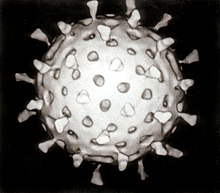Virus
| Viruses | |
|---|---|
 |
|
| Rotavirus | |
| Virus classification | |
| Group: | I–VII |
| Groups | |
|
I: dsDNA viruses |
|
I: dsDNA viruses
II: ssDNA viruses
III: dsRNA viruses
IV: (+)ssRNA viruses
V: (−)ssRNA viruses
VI: ssRNA-RT viruses
VII: dsDNA-RT viruses
A virus is a small infectious agent that replicates only inside the living cells of other organisms. Viruses can infect all types of life forms, from animals and plants to microorganisms, including bacteria and archaea.
Since Dmitri Ivanovsky's 1892 article describing a non-bacterial pathogen infecting tobacco plants, and the discovery of the tobacco mosaic virus by Martinus Beijerinck in 1898, about 5,000 virus species have been described in detail, although there are millions of types. Viruses are found in almost every ecosystem on Earth and are the most abundant type of biological entity. The study of viruses is known as virology, a sub-speciality of microbiology.
While not inside an infected cell or in the process of infecting a cell, viruses exist in the form of independent particles. These viral particles, also known as virions, consist of two or three parts: (i) the genetic material made from either DNA or RNA, long molecules that carry genetic information; (ii) a protein coat, called the capsid, which surrounds and protects the genetic material; and in some cases (iii) an envelope of lipids that surrounds the protein coat when they are outside a cell. The shapes of these virus particles range from simple helical and icosahedral forms for some virus species to more complex structures for others. Most virus species have virions that are too small to be seen with an optical microscope. The average virion is about one one-hundredth the size of the average bacterium.
...
Wikipedia
